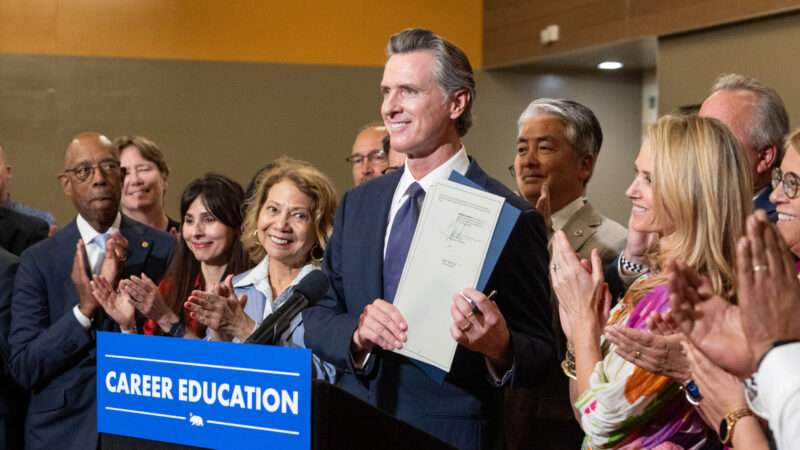
I've recently been investing in some long-deferred maintenance at my home and it should be no surprise to anyone that I've sought to receive as much quality work done for as little money as possible. When people spend their own hard-earned money on such projects, they measure success by results, such as a sparkling new kitchen. They don't brag about how much they spent, but how much they got in return.
By contrast, state officials seem to delight in how much money they "invest" in different priorities, without worrying too much about outcomes. Sure, they sometimes pay lip service to results—but they don't care enough about them to actually change the way they provide public services. (They're not about to annoy the public-sector unions, which represent the people paid to provide those services.)
I'm not the only one to have noticed. State Sen. Steve Glazer (D–Orinda), in a July column about the $310-billion budget, complained that "we've already spent billions of dollars on the same problems—with very little to show for it." He called on his fellow Democrats to ensure that the spending "actually improving the lives of the people we say we are committed to helping." What a novel idea.
This dynamic is most pronounced in public education, which consumes more than 40 percent of the state's general fund budget—plus local bond measures. Although lawmakers slowed education funding increases to close a $32-billion budget deficit this year, as of last year—during an unprecedented $97.5-billion budget surplus—they lavished public schools with money.
"The revised budget directs a total of $128.3 billion to education, lifts up the most critical needs including historic funding for school mental health, recruitment and retention of teachers," boasted Superintendent of Public Instruction Tony Thurmond, following last year's budget deal.
The state spends nearly $24,000 per student a year (including funding from all sources, including the feds). Consider the educational opportunities we would have if parents could spend that much money on private schools, which would compete for tuition. Each class of 25 students would have a budget of $600,000. The governor likes to blather about a re-imagined school system, but in a competitive system we wouldn't have to just imagine it.
By contrast, let's look at what we've actually accomplished after a decade of steadily increasing expenditures. The Public Policy Institute of California reported last year that "pandemic disruptions reversed nearly six years of academic progress." It found only 35 percent of low-income students met the state's English-language standards and only 21 percent met California's math proficiency standards. These are horrifying numbers.
Here's some other news: EdSource reports that nearly a third of the state's public school students are chronically absent. The Independent Institute reports that fewer than half of the state's students are functioning at their grade level and that 70 percent of incarcerated Californians lack even a high school diploma. There might be a connection between those dismal statistics.
But no matter how much the state "invests" in education, it's never enough for the public school establishment. The California Teachers' Association complains that California's per-student school funding lags behind other states—and it, of course, blames 1978's tax-limiting Proposition 13 for the problem and bemoans "our faulty tax structure, which is currently benefiting the wealthiest corporations over Californians themselves."
Does anyone really believe that if California, the highest-taxed state, dramatically increases its property taxes (through a "split roll" that denies Prop. 13 protections to corporations or other erosions of the 1978 tax measure) that California's education system will suddenly become America's finest? Name one instance where throwing more money at an encrusted, union-controlled bureaucracy has done anything other than fund the same old, same old.
Another underreported education story: school budgets are soaring even as enrollments are on a downward trajectory. The state's population is falling and also is aging. Immigration is slowing. Birth rates are declining. As noted above, a lot of students are dropping out or disappearing. Two studies last month from PACE, a research center led by faculty directors at top California universities, found that enrollments have fallen 6 percent since 2007 and are expected to fall more steeply. The impact, it notes, falls hardest on poor and minority students.
"There are many ways districts can reduce programs or services, but they can only operate severely under-enrolled schools for so long before the situation becomes financially untenable," PACE explains, noting the many fixed costs in maintaining a traditional school. The declining schools are losing funding because the state bases its spending on average daily attendance rates.
Not to be overly harsh, but who cares about the plight of school systems trying to fund their overly costly infrastructure of buildings and employees? But once again, California's educational establishment is all about spending more money—rather than getting the best educational outcomes for students. Until that attitude improves, don't expect test scores to improve, either.
This column was first published in The Orange County Register.
The post Test Scores Are Plummeting Despite California Spending Wildly on Education appeared first on Reason.com.







